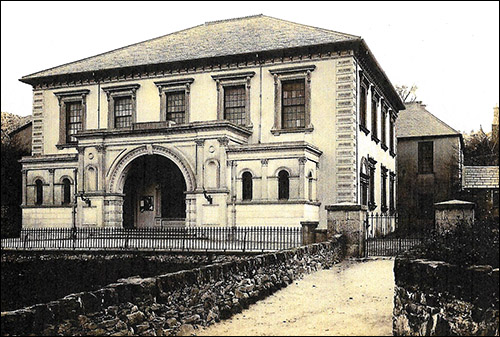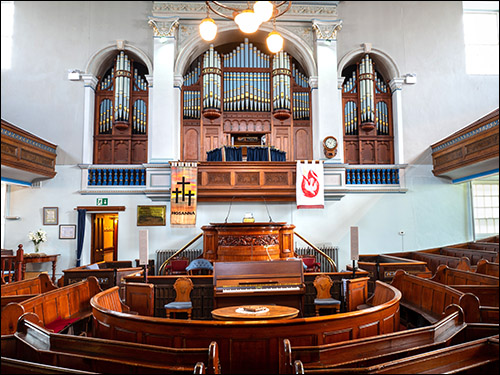Capel Jerusalem, Bethesda
 This Grade 1-listed Calvinistic Methodist chapel was built in 1842 and enlarged in the 1870s. The enlarged chapel could comfortably seat 900 worshippers, or 950 including the “passages”. Behind were a “parlour”, a schoolroom and a lecture room for over 150 people.
This Grade 1-listed Calvinistic Methodist chapel was built in 1842 and enlarged in the 1870s. The enlarged chapel could comfortably seat 900 worshippers, or 950 including the “passages”. Behind were a “parlour”, a schoolroom and a lecture room for over 150 people.
The 1870s interior was designed to help voices carry clearly. The shape was said to resemble an amphitheatre or college lecture hall, with raked seats on the ground floor under the gallery and in the gallery itself. Within the centre are curving pews, and a half-round seat which accommodated a choir and orchestra. At the time, it was a novelty for a Methodist chapel to have an established choir and orchestra.
In 1899 the chapel was crowded for the funeral of Rev Thomas Roberts, minister of Jerusalem and Tyn y Maes chapels since 1867. He died suddenly in a shop in Bangor. Special permission was requested to bury him in the field in front of the chapel but this was refused, and he was buried in neighbouring Glanogwen Churchyard.
The rooms behind the chapel were further expanded c.1900. A new organ was installed, prominent in the interior photo (courtesy of Thomas Bassler). The organ’s celebratory inaugural concert was given on 26 December 1901.
 In April 1903 the vicar of Glanogwen reported on the state of Bethesda to Lord Penrhyn, in preparation for a House of Commons debate about the on-going quarry strike. Bethesda had suffered greatly during the dispute, but as evidence that residents weren't in financial hardship the vicar referred to (among other things) the c.£3,000 raised for Capel Jerusalem's organ and large vestry hall. He was “writing in confidence”, and didn’t wish his name to be mentioned since he wished to live on in Bethesda “and be of some use”.
In April 1903 the vicar of Glanogwen reported on the state of Bethesda to Lord Penrhyn, in preparation for a House of Commons debate about the on-going quarry strike. Bethesda had suffered greatly during the dispute, but as evidence that residents weren't in financial hardship the vicar referred to (among other things) the c.£3,000 raised for Capel Jerusalem's organ and large vestry hall. He was “writing in confidence”, and didn’t wish his name to be mentioned since he wished to live on in Bethesda “and be of some use”.
In February 1919 more than 25 demobilised soldiers were treated to supper at Jerusalem Chapel schoolroom and Rev Alun T Jones “paid a most touching tribute to those who had fallen”.
In 1939 the chapel’s pastor, Rev T Arthur Jones, resigned in protest at the chapel deacons’ refusal to allow wartime evacuees to be schooled in the rooms. Many children had been sent to Bethesda for safety from urban areas of England where air raids were expected. Local schools couldn’t accommodate the influx but the deacons at Jerusalem rejected three appeals against their decision. Mr Jones told the church authorities in his resignation letter that he considered the refusal to be “unworthy of the Christian church and its Founder”.
To view the interior, please arrange with Walter Williams, tel: 01248 601167
With thanks to Dr Hazel Pierce, of The History House, and Thomas Bassler. Sources include: Lindsay, J, 'The Great Strike' (London, 1987).
Postcode: LL57 3AR View Location Map


